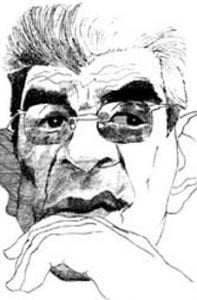
ersatz methodology
The legacy of the French psychoanalyst, Jacques Marie Émile Lacan (b. April 13, 1901 d. September 9, 1981) extends from the 1930s to nearly his death, with major works, such as the collection of essays in Écrits as well as his seminars, given annually from 1953–1981. Lacan was consistent because he was inconsistent. His method of borrowing from everyone made him a plagiarist sans pareil (see Mikel Borsch-Jacobson, Lacan, the Absolute Master, 1991), but a plagiarist who often seemed to know better than the original authors what their work was really all about. In my transition from Vico studies, through the vicissitudes of architectural theory (with a principal debt to Marco Frascari, 1945–2013), to Lacanian studies proper, I had to accept my weaknesses: no knowledge of French, little aptitude for mathematics/topology, and no clinical experience in psychology or psychoanalysis. Given these handicaps, I had no choice but to borrow and adopt the method of mathematicians who, facing a seemingly insolvable problem, advance an “ersatz conjecture” with no particular relevance “just to see what happens” (my characterization. Error data is, after all, data, and the feedback from the idiotic encounter with the actual problem provokes a revision in the “metadata” of the problem: how and why it is conceived as a problem and what conception of the inconceivable can possibly exist prior to any real knowledge. Reformulating, another round of ersatz conjecture yields another round of error data, and at some point it is possible for the theorist to get lucky (Ansatz, the lucky guess). Ersatz speculation is a productive use of the the skeptic’s claim that nothing is known (nihil scitur), but it goes one step further, to include the skeptic’s “at least one truth” (cf. Francisco Sanches, 1551–1623) as the first error, constituting in itself the logic of the forced choice.
These essays vary in their ersatz versus ansatz content, from, say, 10–90% in either direction. The aim is not to justify my position or persuade any reader of my position but, rather, to encourage similar ersatz ventures in the spirit of fou littéraire, that genre of literature, at the foundation of Surrealism, that sought in nonsense the exact opposite.
These essays include experiments with various Lacanian ideas — discourse theory, the poinçon, anamorphosis, projective geometry (Möbius band, cross-cap, torus, etc.), eutuché and dustuché, identity, metaphor, metonymy, etc. — but the general aim is to bend what I see as the two vectors of psychoanalysis, extimity (éxtimité) and anamorphosis, around to meet each other, to the point where one is the lens by which the other comes into clear view. The claim for meta-theoretical dominance has been put forward by Jacques-Alain Miller (for extimity) and by Mladen Dolar (for anamorphosis). That the two are aspects of the same thing can be seen by looking at Freud’s Uncanny, a project so closely tied to art and architecture that there is little need to argue that, here, the ersatz method is critical if not essential. The name for what anamorphosis was before it appeared suddenly in art history with the paintings of Holbein (1533) and the murals at the convent of the Minims was, I claim, “the uncanny.”
If this is like Oscar Levant’s quip, that he “knew Doris Day before she was a virgin,” then the logic of what something was before it was a (virginal) first is ersatz logic at its best. The fact that Lacan himself employs it in Seminar IX (Identification) should encourage every Lacanian to look into the sex life of virgins to understand what, in Lacan-language, is called the “unary trait.”
This work might be condensed into a list of topics that are more or less synonyms of each other. The list changes, but this is what it looks like at the beginning of 2022 (not meant to be helpful or make sense):
- the mirror as a cut rather than a reflection
- symmetry of the void (“symmetrical difference”)
- Euler over Venn
- X = 1 + 1/X as one aspect of the unary trait
- fetish as another aspect (as in the logic of the collection)
- the role of palindromes in the unary trait (“idempotency”)
- metaphor as a paradigm of the neural and perceptual circuit
- the reciprocity of repression and symptom as the dynamic of metaphor
- logical priority discovered after historical primacy
- the Bahnungen of the blah blah blah
- the suppression • symptom relationship and nonsense of the A = ~A
- lateral portability of the ◊ and the void (union, ∪, without intersection, ∩)
- within non-bi-univocal concordance, bijection (1:1) “anyway”
- criticism by punctuation and the sphere
- the theater’s fourth wall
papers relating to psychoanalysis
D. Kunze, “Triplicity in Spencer-Brown, Lacan, and Poe,” “Triplicity in Spencer-Brown, Lacan, and Poe,” in Gauthan Thakur and Jonathan Dickstein, Lacan and the Non-Human (New York andLondon: Palgrave Macmillan, 2018). DOI:10.1007/978-3-319-63817-1_8
D. Kunze, “Extimity, Co-Anamorphosis, and Narrative Surfaces,” Vestigia [forthcoming].
D. Kunze and Anahita Shadkam, “Vertigo’s Idempotent, Anamorphic, Thaumatropic Love” (with Anahita Shadkam), for Shifting Screens, ed. Carol Owens and Sarah Meehan [forthcoming].
“∂stance Doesn’t Matter,” unpublished position paper, a collection and re-positioning of ongoing research.
“The Object Who Knew too Much,” unpublished position paper, a consideration of Orson Welles’ Citizen Kane.
presentations • animations • videos
With every scholarly conference my standard practice would be to develop a Keynote presentation (smoother than PowerPoint), add a recorded narrative, and post the result on YouTube. Sometimes videos would be silent, or have a separate text. Materials and themes clearly overlap, but redundancy was one means of learning how ideas held up to changing contexts, and how Lacan’s concepts, difficult by any measure, would come alive when drawn, diagrammed, or animated.
Orthographics to orthopsychics
LACK conference, Boulder, Colorado, September 26, 2017

Todd McGowan tells an interesting story in his book on psychoanalytic film theory. It’s about Joan Copjec’s single-handed revolution, reversing 30 years of film criticism done in the name of Jacques Lacan. “No no,” said Copjec, in a single essay that showed how Michel Foucault had hijacked the idea of apparatus — dispositif in French — from Gaston Bachelard’s science writings to create the idea that the subject was completely trapped by ideology. The emblem of this entrapment was the Panopticon, a building made famous by a guard tower shielded with venetian blinds so that prisoners couldn’t tell whether guards were present or absent. Foucault claimed that the result was behavior “as if ” guards were always present, but this was not the case. Copjec called out Foucault for misrpresenting the idea of dispositif, but she left intact Foucault’s take on the Panopticon. If Copjek had gone one step further, I claim, the Panopticon itself would have an interesting story to tell, and this is the story of the orthographic drawing, a section cut where building interiors are shown in a 1:1 scale consistent way. The Panopticon is essentially a section drawing turned into a building, with the IDEA of ortho-graphics turned into the IDEA of ortho-psychics — “self-correcting.” I want to reconnect the dots by taking the step Copjec did not take. Because section drawings are not limited to architectural drafting boards, because the idea of a section drawing can be found all over popular culture, literature, and ethnological practices, I hope to show that there is more to the Panopticon than meets the blinded eye.
other works (including Lacan+Vico)
This is a non-chronological list, loosely organized with respect to content and topics.
• Metalepsis of the Site of Exception
• The Ultimate Big Other Announces the End of the World
• Triplicity in Spencer-Brown, Lacan, and Poe
• The Hysteric’s Dreamworld: Uncanny Crossings in The Dead of Night
• Is Not the Alethosphere Not the Perfect Place to Hold a Pandemic?
• Psychoanalysis and/of Architecture The Structure of Latency in Metaphor
• The Lacanian Formula for Fantasy
• Chiasmus, Artificial Memory, and the Arts of Arrangement
• Overdetermination and the Astonishment of the Virtual Real
• Needed Now! A Calculus of Metalepsis
• Death Drive, Succinct Version
• The (Secondary) Virtuality of Rhetorical Truth
• The Natural Attitude versus The Uncanny
• Extimity and Phantasmagoria: Interpretation by the Cut
• Melancholy’s Quantum and the Virtuality of the Real Real
• Why/How Does Anything Have an Unconscious?
• An Invitation to Lacan, Addressed to Architecture Theorists
• Metonymy and the Modern (notes)
• The Middle Voice and Topical Invention
• Naming Recoil — Amazing How Hegel, Lacan, and Sorites All Got Together
• Use Value and Exchange Value